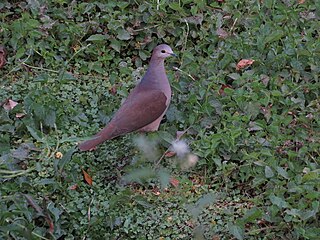
Laurel forest, also called laurisilva or laurissilva, is a type of subtropical forest found in areas with high humidity and relatively stable, mild temperatures. The forest is characterized by broadleaf tree species with evergreen, glossy and elongated leaves, known as "laurophyll" or "lauroid". Plants from the laurel family (Lauraceae) may or may not be present, depending on the location.

Ocotea is a genus of flowering plants belonging to the family Lauraceae. Many are evergreen trees with lauroid leaves.

The Yungas is a bioregion of a narrow band of forest along the eastern slope of the Andes Mountains from Peru and Bolivia, and extends into Northwest Argentina at the slope of the Andes pre-cordillera. It is a transitional zone between the Andean highlands and the eastern forests. Like the surrounding areas, the Yungas belong to the Neotropical realm; the climate is rainy, humid, and warm.

Cinchona officinalis is a South American tree in the family Rubiaceae. It is native to wet montane forests in Colombia, Ecuador, Peru and Bolivia, between 1600–2700 meters above sea level.
Oligoryzomys destructor, also known as Tschudi's colilargo or the destructive pygmy rice rat, is a species of rodent in the genus Oligoryzomys of family Cricetidae. It is found along the eastern Andes from southern Colombia, through Ecuador, Peru, and Bolivia into northern Argentina. Its karyotype has 2n = 60 and FNa = 76.
The southern climbing mouse is a species of rodent in the family Cricetidae. It is found in Argentina and Bolivia in forested valleys and on slopes on the eastern side of the Andes Mountains.

Retrophyllum rospigliosii is a species of conifer in the family Podocarpaceae. It is a large evergreen tree native to the montane rainforests of Venezuela, Colombia, Peru, Ecuador and Bolivia in South America.

The Yungas dove, also known as the white-faced dove or large-tailed dove, is a species of bird in the family Columbidae. It is found in Argentina and Bolivia.

Mangifera zeylanica or "Sri Lanka wild mango" is a wild species of mango tree endemic to Sri Lanka. This stately tree is the tallest member of the mango genus, Mangifera, and one of the two tallest trees in the family Anacardiaceae. The mango fruits are edible and have an excellent taste. It is called "aetamba" (ඇටඹ) or "wal amba" in Sinhala and “kaddu-ma” in Tamil. The well-known British botanist and explorer Joseph Dalton Hooker first described the tree in 1876.

The Southern Andean Yungas is a tropical and subtropical moist broadleaf forest ecoregion in the Yungas of southwestern Bolivia and northwestern Argentina.
Buddleja bullata is a variable species endemic to the Andes, from Venezuela south through Colombia and Ecuador to Peru, at elevations of 1,800–3,600 m, where it grows on stream beds and in the remnants of montane forest. The species was first described and named by Kunth in 1818.

Laurus novocanariensis is a large shrub or tree with aromatic, shiny dark-green foliage. belonging to the evergreen tree genus Laurus of the laurel family, Lauraceae. The genus includes three species, whose diagnostic key characters often overlap. Under favorable conditions it is an impressive tree of 3 to 20 m. tall. It is native of rich soils in the cloud zone of always moist spots in subtropical climate with a high air-humidity, on the Canary and Madeira islands.

Brunfelsia plowmaniana is a species of flowering plant of the nightshade family that is native to the cloud forests of the Bolivian and Argentinian Andes. It was first described in 2012 on the basis of systematic DNA barcoding of specimens from the genus Brunfelsia. Specimens belonging to the new species had previously been placed in the polymorphic species B. uniflora, which a molecular phylogeny revealed as polyphyletic.

Leucostele terscheckii, commonly known as the cardon grande cactus or Argentine saguaro, is a large cactus native to South America and popular in cultivation.

Encephalartos paucidentatus is a species of cycad.
Acaena alpina is a perennial shrub of the genus Acaena known for its hardiness and durability. A. alpina is found throughout central Chile and Argentina. It can withstand a wide range of climates, including that of the Andes, where it is commonly found. A.alpina can withstand both hot and cold temperatures as well as wet and dry seasons, though it preferentially grows at high altitudes. A. alpina was originally typified by Eduard Friedrich Poeppig and Wilhelm Gerhard Walpers in 1843.
Zanthoxylum austrosinense, or South Chinese Sichuan pepper, is a woody plant in the family Rutaceae and is native to southern China.
Zanthoxylum glomeratum is a woody plant in the Rutaceae family, it is native to Southeast and South-Central China.
Ilex argentina, commonly known as Argentina holly, is a species of tree native to northwestern Argentina and Bolivia.
Drimys brasiliensis is a broadleaf evergreen tree of family Winteraceae. it is native to Atlantic Forest of eastern Brazil, western Paraguay, and northwestern Argentina, and to Bolivia.











